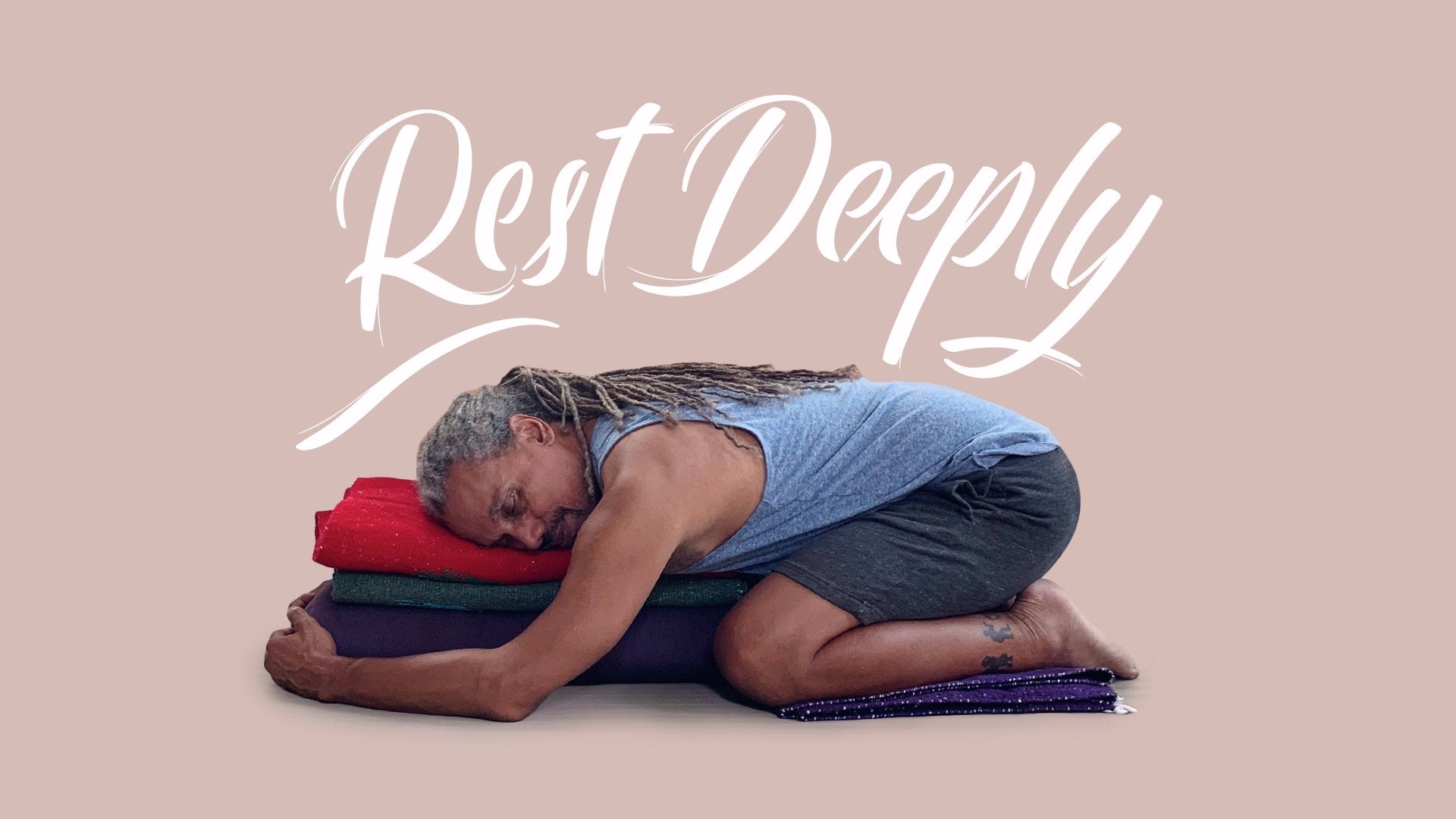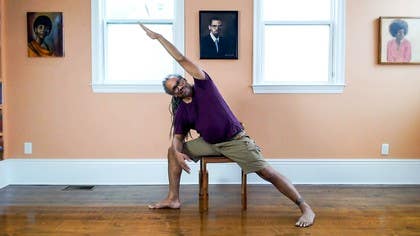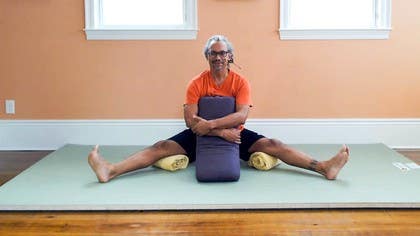Description
About This Video
Transcript
Read Full Transcript
Hi, for this practice we're going to need some props. So I've got three towels over here, and I'm folding them kind of in a long strip, and then I'm going to roll it up, and I'm going to set that to the side. We're going to use these a little later in the practice, and another one, and a long strip, and roll it up. I want these towels to be about the same size when they're rolled up, about the same diameter. And then this third towel, I have it in a long strip, and I'm going to use that on top of my block just to cushion the tush a little bit. But I don't really need that right now. I'll just set that to the back. We're going to do a practice to nourish, to tonify, to basically to love up our kidneys. Again, the kidneys are the motive force of every other organ system in the body, according to Chinese medicine. The kidneys are like the fire at the bottom of the pot that generates the activities of digestion, that generates the movements of respiration in the lungs, and the kidneys and the lungs are very interconnected. So when you strengthen the kidney functions, when you nourish and love up your kidneys, your lungs function better. And we want to have everything functioning as well as possible, pretty much all the time. In Chinese medicine, nourishing the kidneys is a pathway to longevity, because the life seed, they call it Jing in Chinese medicine, the essence of the body is located, is housed in the kidneys. And one of the best ways to nourish the kidneys is to take rest, to take a deep rest, and to practice resting. Practice resting a lot. It doesn't have to be for a really long time, but to get in the practice of unplugging from the hamster wheel, unplugging from the fight or flight situation, the fight or flight energy that is a Western life is really focused on doing, doing, doing, to value and practice deep resting, giving yourself permission to rest in doses, at least daily. One of the practices that I recommend is to try it for a month. Try giving yourself a 20-minute Shavasana during the day sometime, 20-minute rest every day for a month. Just try it and see what happens. It can be really empowering to tune into the rhythms of rest, the rhythms of rest that our body really craves, but as a culture, we've forgotten it. So today's practice, we're going to end with a nice long rest, but we're going to start with some movement. So let's come on up to hands and knees. The knees a little bit behind your hips and the hands just a little bit in front of the shoulders. We're going to start to circle the pelvis and I'm doing this with my toes tucked. You could do it with them tucked or untucked and I can feel already that I want my knees a little bit wider than my hips. So I'm going to start to draw circles with my pelvis. This is actually from Tibetan yoga and go slow enough that you can feel the whole range of movement, shifting over to the side, coming forward, shifting to the other side, coming back. You can do this smaller. You can do this bigger where you almost come into up dog, almost come into child's pose.
And if it's hard on the wrists, you can bring your bolster or couch cushion in front and do it on the forearms. And as you do these circles, you might find a spot that has a there's a speed bump in the movement. Ooh, a tight spot. You can go ahead and take a little pause, do a little moaning groan there. There, tune into the inner sensations of movement. And then come back to the center and go the other way. You can start small. You can slowly make the circles bigger. You can pause. You can moan and groan.
And you may notice with these circles that they're not exactly circles. So this can also show you where there are some hitches in your movements, maybe in the hips, maybe in the shoulders. Oh, maybe in the booty right there. And coming back to the center, walking the knees under the shoulders and the knees under the hips and the hands under the shoulders. We're going to take one hand, reach it long, and then take it between the opposite knee and hand and bring your shoulder all the way down to the ground. Take this opposite leg, straighten it out with the toes tucked underneath, and then your gaze is going to look up under your armpit towards the ceiling. And just take a, it's kind of a twisty forward bendy stretch here. Take a few breaths here. Your next inhale, unwind and come back to hands and knees. Take the other hand, lengthen it out, and then reach it between the knee and the palm. Straighten the other leg out, bring the shoulder all the way to the ground, and look up towards the ceiling.
You may want to lean a little forward into the shoulder, into the stretch. And breathe. Next inhale, unwind and come back to hands. Next inhale, unwind and come back to all fours. Walk the hands out. You're going to keep your booty in the air.
Walk the hands out and come on to the forearms. Maybe your forehead can come down to the floor. Maybe you need a little extra height under your forehead. Oh yeah, that feels better. And then from here, take the knees just a little bit wider. Booty is up high in the ground, so this is very much like a playful puppy position. But then you're going to take your hands, your head over to one side, and since I'm going to the left, I'm going to walk my right fingertips forward to stretch my right ribcage and armpit zone into the right kidney area. And take some breath into that right side of the body.
I want to feel the ribs expanding, especially the low ribs that are housing and protecting the kidneys. The intention of bringing breath, bringing chi, bringing prana into the kidneys on that right side. And your next inhale, come back to center. And then come over to the other side, walking the hands, head and heart over to the other side. And then this hand walks forward to stretch along the whole side body.
You can let your palm stay sticky as your hips sink away from your hands just a little. That gives a little more stretch, if that feels good. And breathe. Breathe. Take the intention of your breath right into the kidney zone, the lowest ribs on each side of the spine, deep to all the internal organs. And then inhale your way up a little and back to the center. And walk your hands down onto your belly. You can make a little pillow with your hands and turn your nose to the side, turn your nose straight down, or if it's comfortable to rotate, you can do that.
And then rock your hips side to side. There's a type of massage called Traeger, which is all about rocking. You'll spend about 40 minutes rocking your pelvis like this. And the idea is to get this wave of movement to travel through the whole body. Since our bodies are mostly water, waves travel nicely through the water inside our bodies. Come back to center.
I'm going to slide the elbows a little bit underneath the shoulders, coming into a gentle back arch. Now I'm going to exaggerate here. I'm gently pulling my elbows towards my hips, but keeping them stuck into the mat, and I'm keeping my hips stuck into the mat. So I'm going to tractioning out my low back by drawing my elbows this direction without moving while my pelvis is glued into the mat. And I can snake my shoulders forward to try and get more length out of the low back. I'm going to do a very low back arch here. Highest here will be having my elbows right underneath my shoulders, but if that's too high, I could walk my elbows out a little bit and still get that lengthening traction. Notice if your shoulders are up by your ears. See if you can shrug them down a little bit and breathe into the low back here into the kidneys again. Remember that energy follows intention. So as you bring your intention to breathing in juicy energy into the kidneys, breathing in love and safety to the kidneys, your kidneys will absorb that. On your next exhale, come forward, rest your forehead or turn your head to the other side. Take a few belly breaths here while you're resting on your belly. I think the belly breathing while you're on your belly or in a pose like child's pose really helps you feel the the back part of your breath. We usually think of the breath as moving on the front of our body because that's where our eyeballs are. But breath is a three-dimensional, a multi-dimensional movement. It expands us to the back. It expands us towards the earth and towards the sky. It expands us sideways also and bringing your palms underneath your shoulders. Press up to all fours again. Walk the hands back. We're going to set up for a forward fold. So I'm going to take my block and if you don't have a block you can stack several blankets like this so that you have a little height. I'm using this block because I have tight hamstrings.
I admit it freely. So the tighter the hamstrings, the higher the throne, the closer to God. I'm going to come sit on my throne and take my legs out wide and bring these rolls right underneath my knees. Now you may be, depends on your hips, your legs may be more forward. They may be wider but I want to be able to sit up and have a little arch in the back. So that may mean a little higher throne or even a lower throne. If you're really loosening the hamstrings you may just sit on one folded blanket and then bring your bolster or couch cushion in front. We're going to bring the hands here and start to draw circles. Imagine that you have a laser pointer coming out the top of your head and you're going to draw some circles on the ceiling with your torso movements. You will probably feel this through the hamstrings on the backs of the thighs and maybe the adductors on the inner thighs. Still breathing. And then reverse directions. And then come back to the center. Sit up tall. You're going to stay seated like this. I'm going to turn around to show you where we're going to do a little self-massage. With the legs out still you're going to bring your hands to your back. It's going to be the index finger side of the back and draw circles over your kidneys as we hang out in the spokes. So bringing the hands to the back, sitting up tall, inhaling and exhaling in the zone of the kidneys, the neighborhood of the kidneys.
In Chinese medicine the things that weaken the kidneys are things like the emotion of fear or fright. Also what weakens the kidneys is not getting enough rest, like having a real partying lifestyle, not getting enough sleep. And the things that tonify the kidneys are doing the opposite. Feeling safe. Finding and creating your own safety. Taking the time to rest deeply. And that may mean doing things like not watching the news after 6pm. That's one thing I've been doing. I don't watch or read any news after 6pm and I sleep so much better. Getting to bed at a decent hour can be helpful. But everybody is different so find what works for you. Release the hands. Sit up tall, inhale and then as you exhale tilting forward your hands can come down to the bolster or to the floor. Some of you may be able to flop your chest all the way down on the bolster. If so you can turn your head to the side. Some of us might want to take our couch cushion and bring it up in an angle. Hug it into the chest so we can just rest into it here. We're going to take about five breaths and then a few minutes rest here. Staying in this gentle stretch. We want to feel it more in the hamstrings on the back of the thigh and the inner thigh muscles. More there than in the back. And what helps get that feeling is to keep a slight arch in the low back. Next few breaths as you inhale. When you exhale let it out. Ahh. Inhale into the kidneys.
Ahh. Ahh. Ahh. And then letting go of the effort with the breath and just resting here. And if you're inspired to keep moaning on the exhale you can let that happen. Breathing in the resonance, the truth of safety. Breathing out fear.
Breathing out stress. Breathing in deep rest. Ahh. On your next big inhale you can start to slowly sit up and then take your bolster off to the side or your couch cushion and then very slowly bring the legs in. You might be a little achy because we've been stretching that for a while. And I'm going to come down off of my throne because I need all three of my blankets. So I'm going to take one and unroll it. And it's going to be about as wide as the center of my chest. If you're using a bolster you want it about as wide as the bolster. But a couch cushion this is going to be a little narrower than a couch cushion. I'm going to go ahead and use all three that I have. And slide my throne to the side and then I'm going to come and sit side saddle with my hip right in line with the bolster. And sit up tall inhaling. Exhale turn towards the bolster and walk my hands out and then turn my nose so my nose is going the same direction as my knees.
So I have a few options here with my legs. I can stack the knees and if you have sacroiliac instability this is the one I'd recommend. You may want to slide your top knee so it comes to the sole of the bottom foot. That one's a little deeper and it puts a little more torque on the SI joint. And as you arrive here notice what your elbows are doing. If you're propped up on your elbows walk your elbows out just a little bit so that your heart is resting into the bolster. Your belly has space to breathe and you're well supported in this twist. If your neck doesn't like turning this far you can turn your nose to the floor towards the floor and make a little pillow with your forehead so your nose has space. Take a few slow deep belly breaths here.
Breathing into the area of the kidneys and the low back. And we're in this gentle ringing position, gentle squeezing position of a twist. Twists are a great way to wring out all of the layers of our body, mind, and spirit. We're wringing out the physical layers of muscles and organs, helping to squeeze stuck blood out of the muscles, helping to squeeze stuck stuff out of the digestive system, helping to squeeze stuck lymphatic circulation. Just like when you wring a washcloth out, the wringing squeezes the stagnant stuff out.
We're also wringing the meridians and nadis the energy pathways, helping to squeeze out stuck or stagnant energy. We're also squeezing out stuck emotional layers from our body, mind. Sliding the palms back underneath your shoulders, let your head stay heavy. Press down, let your head and neck stay relaxed, and roll your way up. Coming up to sitting side saddle, and then turn away from the bolster.
Swing your legs over to the other side, sitting side saddle on this side. Inhale yourself up tall, exhale, turn towards the bolster, and walk your hands forward, and then find a comfortable position for your head and neck. The legs, if you had the knees stacked on the other side, go ahead and stack them again on this side, or if you slid the top knee down to the sole of the bottom foot, you can do that. And then the arms, again notice if you're propping up on your elbows, slide the elbows wide, and find a comfortable position. My neck won't rotate as far on this side, so I've brought a little extra pillow of my palm underneath my forehead.
Coming into the second twist, the second ringing, and just like the washcloth, when you squeeze it out a second time, you squeeze out deeper layers of stuck stuff. Squeezing out deeper layers of stuck blood, stuck stuff in the digestive system, digestive system, squeezing out deeper layers of stuck energy and emotions. And just like the washcloth, as we're squeezing it out, we want to rinse that stuck stuff away. We can use our body, our breath, like water, so our breath is rinsing and cleansing as we're squeezing these stuck layers out of our body mind. And sliding the palms back underneath the shoulders, let your head stay heavy as you press down and slowly roll up.
Coming to sit side saddle. Once you're up, you can turn your leg support sideways and take the top one and bring it around behind you. That's going to end up to be your head pillow. Bring this underneath your knees, use your hands and your abs to slowly come on back. Once you're back, adjust that head pillow just right. Find a place and a role that helps the front of your neck soften, so you're not lifting your head, but your head can surrender.
You can even gently rock your head a little side to side to help you find that super yummy spot. Wiggling is always good to find more space, to find more ease, even in Shavasana. You want to find the greatest ease, the greatest space, the greatest the greatest support for your surrender. Bring your awareness back to your kidneys again, where we were massaging a little earlier and take a few breaths into the kidneys and out from the kidneys. Breathing in the knowledge that you're safe now.
Breathing out any excess stress, right here, right now, you're safe. Ah, letting go of the temptation to hold on to fear. Ah, with the hands outstretched, the legs extended. See if you can find your ankles from the inside and soften your ankles and let your toes go. So, tune into your knees and let them go with an exhale.
Bring your awareness into your hips and let them find softness, ease, and space. Bring some awareness to your whole spine, from your tailbone, up through the low back, up behind your stomach and heart and lungs, all the way up into the neck, to the base of the skull. Ah, let it rest, that whole chain of bones sinking in towards the floor. Find your wrists and let your fingers and palms get soft. Good. Your elbows and the forearms can relax.
Find the shoulders and let them surrender all the way out into the arms and hands, all the way connected into the spine and neck. Find your skull, your jaw, your teeth, and let them get a little heavier, a little more spacious. Turn into your eyes, your scalp, and your ears. And let them all go. So, soft face, letting go of your entire body.
Surrendering to the support of the floor and the earth beneath the floor. Just rest. Just rest. Hmm. You are welcome to stay in this final relaxation.
For as long as you like. For those ready to come up, start to deepen your breath and bring some awareness into the edges of your body, your toes, your fingers, your scalp. You can lengthen your body. And if you're ready to start coming up, bend one knee at a time up, then roll onto one side and bring your knees up towards your chest. You can fold that head pillow up a little higher so your head and neck feel supported.
And take a few breaths into your low back, into your kidneys. From your side, roll a little bit forward. Let your head and neck stay heavy, slowly rolling up one vertebrae at a time. And coming up to find a comfortable seated position. Ah, whether you're seated or still in shavasana, bring some awareness back to the area of your kidneys and breathe in some gratitude to the kidneys and breathe in the resonance of thanks for your support. Thanks for all you do.
Bring your palms together and hands in front of your heart. And now let's stay.
Rest Deeply
Comments
You need to be a subscriber to post a comment.
Please Log In or Create an Account to start your free trial.
















